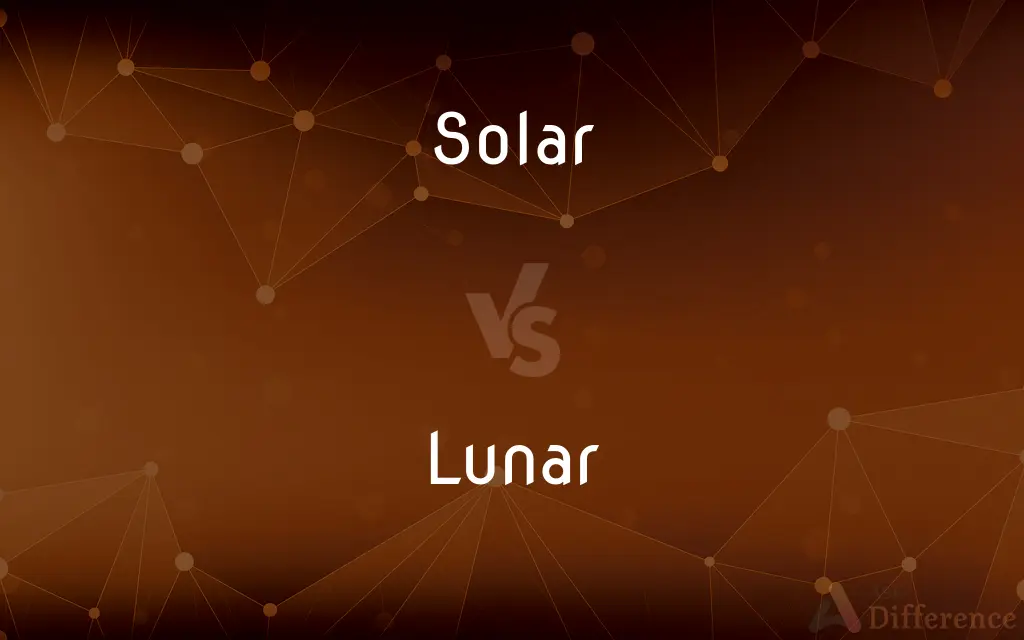Solar vs. Lunar — What's the Difference?
Edited by Tayyaba Rehman — By Fiza Rafique — Published on October 6, 2023
Solar pertains to the sun, while lunar relates to the moon.

Difference Between Solar and Lunar
Table of Contents
ADVERTISEMENT
Key Differences
Solar, by definition, pertains to the sun or its energy. We see its significance in terms like "solar power," which refers to energy derived from the sun's rays. Solar phenomena, like solar flares or solar eclipses, directly involve the sun's activity or position relative to the Earth. On the other hand, Lunar is a term specifically associated with the moon. Lunar phases, for instance, chart the moon's appearance from Earth as it orbits our planet.
Diving deeper into Solar, it's evident how central the sun is to our planetary system. Without solar energy, life on Earth would be impossible, as it powers everything from the climate to photosynthesis. Conversely, Lunar aspects, like lunar tides, result from the moon's gravitational influence on Earth. The ebb and flow of tides correspond with the moon's position relative to our planet.
It's intriguing to think about human interaction with Solar and Lunar phenomena. Solar energy is harnessed for sustainable power, reducing our carbon footprint. At the same time, Lunar cycles have been central to calendars and agricultural practices for millennia, marking time and guiding sowing and harvesting.
In the realm of exploration, both Solar and Lunar domains offer immense promise. While solar studies help understand stars and their lifecycles, lunar exploration, like the Apollo missions, has expanded our knowledge of the moon and our own planet's origins.
Solar is derived from the Latin word "sol," which means "sun." Anything described as solar is in some way connected to or influenced by the sun. Lunar, on the other hand, originates from the Latin word "luna," which translates to "moon." Consequently, lunar characteristics or events are tied to the moon.
ADVERTISEMENT
In the realm of energy, solar power is harnessed from the sun's rays. It involves capturing sunlight and converting it into electricity. In contrast, lunar energy, though less commonly discussed, could reference tidal energy, which is influenced by the moon's gravitational pull on Earth.
Calendars also provide a clear distinction. Solar calendars, like the Gregorian calendar, are based on the Earth's rotation around the sun. Lunar calendars, such as the Islamic Hijri calendar, rely on the phases of the moon, marking time by the moon's cycles.
Solar and lunar eclipses offer a celestial comparison. A solar eclipse occurs when the moon passes between the Earth and the sun, casting a shadow on the Earth. A lunar eclipse transpires when the Earth comes between the sun and the moon, causing the Earth's shadow to fall on the moon.
Comparison Chart
Related Celestial Body
Sun
Moon
Energy Source
Solar energy, harnessed from sun rays
N/A
Phenomena Examples
Solar flares, solar eclipses
Lunar phases, lunar eclipses
Effects on Earth
Drives climate, photosynthesis
Influences tides, calendars
Exploration
Study of stars, solar system
Moon landings, study of moon's surface
Source Language
Latin "sol"
Latin "luna"
Energy Reference
Sunlight, solar panels
Tidal energy, moon's gravitational pull
Calendrical Basis
Solar calendar (e.g., Gregorian)
Lunar calendar (e.g., Hijri)
Eclipse Type
Solar eclipse (moon between Earth and sun)
Lunar eclipse (Earth between sun and moon)
Compare with Definitions
Solar
Relating to the sun.
The Solar System revolves around the sun.
Lunar
Pertaining to the moon.
Lunar craters are visible with a telescope.
Solar
Of or produced by the sun.
Solar radiation is integral for life on Earth.
Lunar
Concerning moon-based events or phenomena.
Lunar eclipses happen when Earth casts a shadow on the moon.
Solar
Powered by sunlight.
The house is equipped with solar panels.
Lunar
Influenced by the moon.
Lunar tides are a result of the moon's gravitational effect on Earth.
Solar
Determined by the sun.
A solar day is the time it takes for the sun to return to the same position in the sky.
Lunar
Indicative of the moon's appearance or position.
The lunar cycle dictates the moon's visible shape from Earth.
Solar
Concerning sun-derived energy.
Solar panels capture sunlight and convert it to electricity.
Lunar
Referring to moon-related explorations or studies.
The lunar landing in 1969 was a monumental achievement.
Solar
Indicative of the sun's position or phases.
Solar noon is when the sun is highest in the sky.
Lunar
Relating to moon-influenced activities.
Lunar calendars are based on the moon's phases.
Solar
Relating to or resembling the sun.
The plant requires direct solar exposure to thrive.
Lunar
Of, determined by, or resembling the moon.
Lunar landscapes often appear barren and devoid of life.
Solar
Of or relating to solar energy.
Solar technology has become more affordable in recent years.
Lunar
Pertaining to or characteristic of moonlight.
The garden was bathed in a gentle lunar glow.
Solar
Pertaining to the region of space around the sun.
Solar flares can disrupt satellite communication.
Lunar
Connected with the exploration of the moon.
Lunar missions in the 1960s and 1970s provided valuable insights into our satellite.
Solar
Of, relating to, or proceeding from the sun
Solar rays.
Solar physics.
Lunar
Of, involving, caused by, or affecting the moon.
Solar
Using or operated by energy derived from the sun
A solar heating system.
Lunar
Measured by the revolution of the moon.
Solar
Determined or measured in reference to the sun
The solar year.
Lunar
Of or relating to silver.
Solar
Of or pertaining to the sun; proceeding from the sun
Lunar
Of, pertaining to, or resembling the Moon (that is, Luna, the Earth's moon).
Lunar observations
A lunar eclipse
Solar
Born under the predominant influence of the sun.
Lunar
Shaped like a crescent moon; lunate.
Solar
Measured by the progress or revolution of the sun in the ecliptic; as, the solar year.
Lunar
Extremely high.
Solar
Produced by the action of the sun, or peculiarly affected by its influence.
Lunar
(Believed to be) influenced by the Moon, as in character, growth, or properties.
Solar
Solar energy
Lunar
Of or pertaining to silver (which was symbolically associated with the Moon by alchemists).
Solar
(obsolete) A loft or upper chamber forming the private accommodation of the head of the household in a medieval hall; a garret room.
Lunar
(astronomy) Of or pertaining to travel through space between the Earth and the Moon, or exploration and scientific investigation of the Moon.
Solar
A loft or upper chamber; a garret room.
Lunar
(anatomy) The middle bone of the proximal series of the carpus in the wrist, which is shaped like a half-moon.
Solar
Of or pertaining to the sun; proceeding from the sun; as, the solar system; solar light; solar rays; solar influence. See Solar system, below.
Lunar
An observation of a angle]] between the Moon and another celestial body, especially for establishing the longitude of a ship at sea.
Solar
Born under the predominant influence of the sun.
And proud beside, as solar people are.
Lunar
Of or pertaining to the moon; as, lunar observations.
Solar
Measured by the progress or revolution of the sun in the ecliptic; as, the solar year.
Lunar
Resembling the moon; orbed.
Solar
Produced by the action of the sun, or peculiarly affected by its influence.
They denominate some herbs solar, and some lunar.
Lunar
Measured by the revolutions of the moon; as, a lunar month.
Solar
Relating to or derived from the sun or utilizing the energies of the sun;
Solar eclipse
Solar energy
Lunar
Influenced by the moon, as in growth, character, or properties; as, lunar herbs.
Solar
Pertaining to sun-centered celestial patterns.
A solar eclipse occurs when the moon obscures the sun from Earth's view.
Lunar
A lunar distance.
Lunar
The middle bone of the proximal series of the carpus; - called also semilunar, and intermedium.
Lunar
Of or relating to or associated with the moon;
Lunar surface
Lunar module
Lunar
Measured by the moon's cycles or phases.
The lunar month is approximately 29.5 days.
Common Curiosities
What does Solar refer to?
Solar pertains to the sun or phenomena related to it.
How is Lunar different from Solar?
Lunar relates to the moon, while Solar pertains to the sun.
What causes a Solar eclipse?
A solar eclipse occurs when the moon blocks the sun from Earth's view.
Can Solar energy be used for electricity?
Yes, solar panels capture and convert sunlight to electricity.
How does Solar radiation affect Earth?
Solar radiation drives Earth's climate and is essential for processes like photosynthesis.
Why are there Lunar tides on Earth?
Lunar tides result from the moon's gravitational influence on Earth.
Is there such a thing as a Lunar calendar?
Yes, lunar calendars are based on the moon's phases.
Are Lunar phases consistent?
Yes, lunar phases follow a consistent cycle as the moon orbits Earth.
How does the lunar calendar differ?
The lunar calendar marks time by the moon's cycles or phases.
What's a well-known Lunar event?
The lunar landing in 1969 by the Apollo 11 mission is iconic.
Can Solar energy be stored for later use?
Yes, using batteries or other storage solutions, solar energy can be stored for later use.
Is solar energy renewable?
Yes, solar energy is renewable as it's sourced from the inexhaustible sunlight.
What's the lunar surface made of?
The lunar surface consists of rocks, dust, and regolith formed by meteor impacts.
What's a solar flare?
A solar flare is a sudden flash of brightness on the sun's surface, releasing vast amounts of energy.
What's a solar calendar's basis?
A solar calendar is based on the Earth's rotation around the sun.
Why does the lunar surface have craters?
The lunar surface has craters due to impacts from meteoroids over billions of years.
Are solar eclipses rarer than lunar ones?
Solar eclipses are less frequent than lunar ones and are visible from a smaller portion of the Earth.
Can solar power be stored for night use?
Yes, solar power can be stored in batteries for use when the sun isn't shining.
Are there lunar-based energy sources?
Tidal energy, influenced by the moon's gravitational pull, is a lunar-related energy source.
How does lunar gravity compare to Earth's?
Lunar gravity is about 1/6th as strong as Earth's gravity.
How do solar days and lunar days differ?
A solar day is based on the sun's position in the sky, while a lunar day is based on the moon's rotation and orbit around Earth.
Is solar energy the same as sunlight?
Solar energy is derived from sunlight but refers specifically to the harnessing of the sun's energy for use.
Are solar panels effective in cloudy regions?
Solar panels can still function in cloudy regions, but their efficiency might be reduced.
How often do lunar eclipses happen?
Lunar eclipses happen at least twice a year, but their visibility varies by location.
What causes lunar tides?
Lunar tides are influenced by the moon's gravitational pull on Earth.
Share Your Discovery

Previous Comparison
Content Analysis vs. Discourse Analysis
Next Comparison
Resignation vs. RetirementAuthor Spotlight
Written by
Fiza RafiqueFiza Rafique is a skilled content writer at AskDifference.com, where she meticulously refines and enhances written pieces. Drawing from her vast editorial expertise, Fiza ensures clarity, accuracy, and precision in every article. Passionate about language, she continually seeks to elevate the quality of content for readers worldwide.
Edited by
Tayyaba RehmanTayyaba Rehman is a distinguished writer, currently serving as a primary contributor to askdifference.com. As a researcher in semantics and etymology, Tayyaba's passion for the complexity of languages and their distinctions has found a perfect home on the platform. Tayyaba delves into the intricacies of language, distinguishing between commonly confused words and phrases, thereby providing clarity for readers worldwide.











































